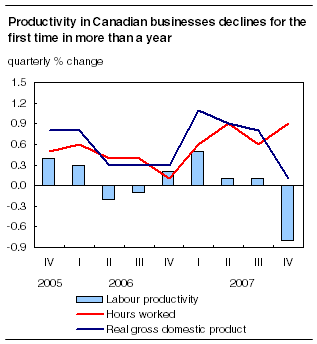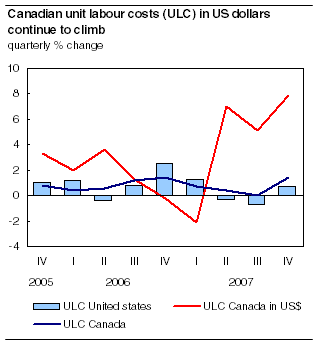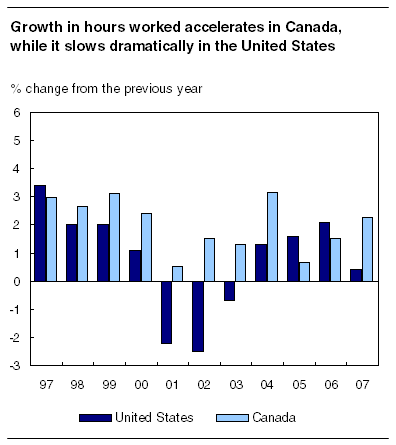Common menu bar links
Labour productivity, hourly compensation and unit labour cost
Archived Content
Information identified as archived is provided for reference, research or recordkeeping purposes. It is not subject to the Government of Canada Web Standards and has not been altered or updated since it was archived. Please "contact us" to request a format other than those available.

The labour productivity of Canadian businesses fell for the first time in more than a year in the fourth quarter. This occurred as gross domestic product (GDP) growth slowed while hours worked continued to increase steadily. By definition, productivity improves when the GDP rises more than hours worked.

In the fourth quarter, productivity lost 0.8%, after posting a slight 0.1% increase in each of the previous two quarters, and a 0.5% gain in the first quarter. For 2007 as a whole, labour productivity increased a mere 0.5%, the lowest annual increase since 2004.
For US businesses, the quarterly labour productivity decelerated significantly in the fourth quarter, increasing only 0.2%, after rising by 1.6% in the third quarter.
Despite this slowdown, US businesses had a revised growth of 1.9% in their productivity for all of 2007, an improvement compared to the 1.0% for 2006.
In 2007, US businesses had higher productivity gains than their Canadian counterparts. During the previous two years, the differential in annual productivity growth between the two countries was slightly in favour of Canadian businesses.
Note to readersThis release contains a brief analysis of detailed data on labour productivity growth and other related variables. A more thorough analysis, including additional charts and tables, is available in the Canadian Economic Accounts Quarterly Review. The term "productivity" in this release refers to labour productivity. Calculations of the productivity growth rate and its related variables are based on index numbers rounded to one decimal place. For more information about the productivity program, see the National Economic Accounts module on our website. You can also order a copy of a technical note on the quarterly estimates of productivity by contacting Client Services (productivity.measures@statcan.gc.ca). Revisions For this release, the Canadian estimates were revised retroactively to the first quarter of 2007. In the United States, the Bureau of Labor Statistics has revised its quarterly data retroactively to 2003. |
The overall drop in productivity reported in the fourth quarter for Canadian businesses was mainly due to a significant decrease in the professional, scientific and technical services, construction and mining and oil and gas extraction. Moreover, productivity in manufacturing fell for the first time since the third quarter of 2006.
By contrast, significant productivity gains were posted in wholesale trade, utilities and in accommodation and food services.
Fourth quarter 2007
Production slowdowns affect Canadian as well as US businesses
The fourth quarter slowdown in North American economic activity had a negative impact on labour productivity in Canada as well as in the United States.
In the third quarter, the value added in the business sector increased by 0.8% in Canada and 1.4% in the United States. In the fourth quarter, the increase in production slowed significantly, posting a weak rise of 0.1% in both countries.
In the fourth quarter, it was mainly the sharp 2.2% fall in exports that limited Canadian business GDP growth, whereas in the United States, the weak business GDP resulted from the slowdown in consumer spending and exports. A decrease in business inventories and a new slowdown in real estate also contributed to the slowdown in the US GDP.
The difference between Canadian and US productivity growth also stemmed from the differences between their labour market activities.
Hours worked devoted to production in Canadian businesses grew 0.9% in the fourth quarter, more than the rise posted for the previous quarter (+0.6%). Full-time work accounted for slightly more than half of the increase in hours worked in the fourth quarter.
By comparison, hours worked in US businesses fell by 0.2% in the fourth quarter, the same as in the previous quarter. The volume of hours worked fell in three of the four quarters of 2007.
Unit labour costs rise in both countries
Labour cost per unit of production, a measure of inflationary pressures from wages, rose by 1.4% for Canadian businesses in the fourth quarter. This was a sharp appreciation from the zero growth posted in the previous quarter.
In the fourth quarter, hourly compensation in Canada had a quarterly increase of 0.6%, compared to 0.2% in the third quarter.

The unit labour cost for US businesses increased 0.7% in the fourth quarter, after two quarters of decreases. In the previous quarter, the cost of labour fell by 0.7% in the United States.
The sharp appreciation in the Canadian dollar in the fourth quarter led to a 7.9% jump in the Canadian unit labour cost in US dollars, after strong increases of 5.1% in the third and 7.0% in the second quarter.
The manufacturing sector: Hours worked decrease less than production
In the manufacturing sector, productivity fell by 0.4% in the fourth quarter. This was the first decrease since the third quarter of 2006.
This slowdown in the fourth quarter brought the growth in manufacturing productivity for 2007 to 1.9%, compared with a slight decrease of 0.1% in 2006.
Hours worked in manufacturing fell sharply by 1.2% in the fourth quarter, the seventh straight quarterly decline, reflecting continued restructuring in this sector.
Meanwhile, production in manufacturing declined for the second consecutive quarter, falling 1.6% in the fourth quarter, after dropping 0.8% in the third. The manufacturing sector has been hampered by the sharp increase in the costs of energy and other raw materials, and by foreign competition, which rose following the appreciation of the Canadian dollar.
Canadian manufacturers had to cope with the 6.0% appreciation in the Canadian dollar against its US counterpart in the fourth quarter, following 4.9% appreciation in the third quarter, and 6.3% in the second quarter.
However, Canadian businesses made the most of this latest appreciation in the loonie, and invested in machinery and equipment to improve their efficiency. These purchases rose by 3.4% in the fourth quarter, about the same as in the previous quarter (+3.3%).
Review of 2007
Productivity growth slows in Canada, but accelerates in the United States
Canadian productivity decelerated to its slowest growth in three years in 2007, rising only 0.5%, compared to 1.1% in 2006.
By comparison, US productivity increased by 1.9% in 2007. This was an acceleration compared with the annual rate of 1.0% posted in 2006, marking the end of the slowing that began after the peak of 4.1% reached in 2002.
During the previous two years, Canadian businesses achieved higher productivity gains than their US counterparts. However, the gap in productivity growth swung back in favour of the United States in 2007, mainly because of the different increases in hours worked in the two countries.

The volume of hours worked in Canadian businesses continued to rise steadily, increasing 2.2% in 2007, compared to 1.5% in 2006. In the meantime, the volume of hours worked in US businesses rose by only 0.4% in 2007, much less than in 2006 (+2.1%).
Three-quarters of the increase in the number of jobs in Canada in 2007 were attributable to full-time work. In 2007, the number of jobs rose steadily in Canadian businesses (+2.2%), at a rate comparable to that for hours worked.
In terms of GDP growth, Canadian businesses outdid their US counterparts for the first time in four years. The growth in real GDP in Canadian businesses reached 2.6% in 2007, a similar pace to 2006. Meanwhile, the GDP in US businesses rose 2.3% in 2007, the slowest growth rate since 2002 (+1.5%), and down sharply from 3.1% in 2006.
In 2007, the tightening of the labour market in Canada, especially in the West, continued to push up hourly wages (+3.7%), although at a slower pace than in 2006 and 2005, which saw increases of 4.2% and 5.2% respectively. However, it was much higher than the 2.6% annual average growth registered between 2001 and 2004.
The modest 0.5% rise in productivity, combined with this strong growth in hourly compensation, resulted in a significant 3.2% increase in the unit labour cost.
With the 5.3% appreciation of the loonie compared to its US counterpart in 2007, Canadian unit labour cost in US dollars jumped 9.5% in 2007, compared to 3.1% south of the border.
Available on CANSIM: tables 383-0008 and 383-0012.
Definitions, data sources and methods: survey number 5042.
A more comprehensive analysis, including additional charts and tables, can be found in the fourth quarter 2007 issue of Canadian Economic Accounts Quarterly Review, Vol. 6, no. 4 (13-010-XWE, free), which is now available from the Publications module of our website.
First quarter 2008 data for labour productivity, hourly compensation and unit labour cost will be released on June 13.
To order data, contact Client Services (productivity.measures@statcan.gc.ca). For more information, or to enquire about the concepts, methods or data quality of this release, contact Jean-Pierre Maynard (613-951-3654; fax: 613-951-3618; maynard@statcan.gc.ca), Income and Expenditure Accounts Division.


 Table(s).
Table(s).